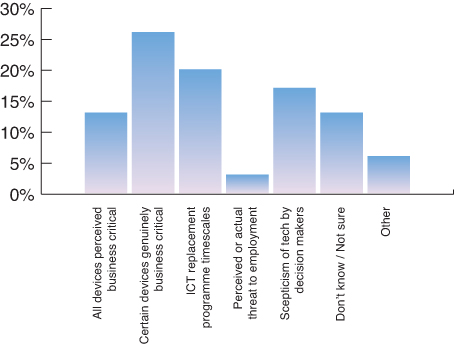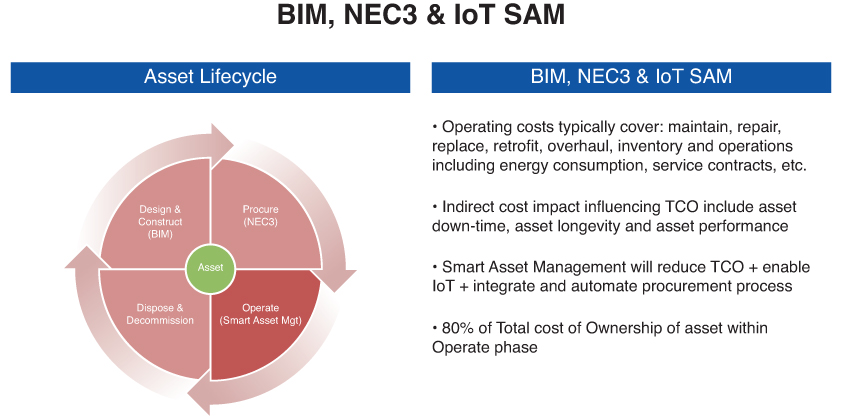Karl Redmond, Director for EDB Architects and Lead Consultants, discusses the Smart Asset Management project and how it saves on costs while ensuring improvements
Following the publication of the article, ‘How NHS Estates are developing BIM, the NEC3 contracts and IoT’, October 2016, Enable by Design (EBD) have been busy, with partners, refining the Smart Asset Management (SAM) project. The SAM project supported by the Internet of Things (IoT) and preceded by EBDs understanding of BIM and NEC3, aims to provide a solid foundation for greater certainty regarding capital and operational expenditure as well as ongoing asset measurement, performance refinements and component evaluation. All of which are seen as tangible outputs for clients with identifiable cost savings and continuous quality improvements. It also has the added benefit of being wrapped up and packaged in a transparent, easy to access and useable process that will help with procurement times, inventory management and many more key issues facing the many sectors dealing with estates and facilities management.
The SAM information gateway is built on an existing and deeply embedded process utilised by facilities management groups from many sectors including the NHS. The SAM system has the relevant analytical programs that will draw out data from the client’s requirements request, which starts and instigated by EBD’s understanding of the combined BIM and NEC3 contractual methodologies. The SAM system provides the perfect two-way information flow from product manufacturer through to the client and more importantly back the other way. This two-way process develops a granular understanding of the asset and individual components in the chosen environment in which it is operating. The data flowing from SAM, utilising the unlimited potential of the IoT, is growing and unearthing new valuable opportunities for the client to save key resources and clearly demonstrates cost savings to Financial Directors and CEOs alike.
The project is going from strength to strength, and more interest is being generated by manufacturers, contractors, digital experts, technology groups and more. Although the most significant increase in interest is coming from clients – we are finally seeing a ‘pull’ for the offering, based on the combined professional expertise EBD and others have harnessed, mobilised and driven forward.
IOT is removing barriers between IT and OT

However, it has not all been plain sailing. The biggest barrier is still inertia and culture change. EBD are advancing, with partners, and tackling the cultural blockers head-on, which is not always comfortable or easy, but the aim, ultimately, is to include them with us on the journey and not to exclude them. We appreciate that what we are developing can cause difficulties and could be viewed as a threat, but we feel what we are developing is the exact opposite. We are attempting to create positive, highly disruptive, efficient, end-to-end and joined up operations with on-going physical asset measurement and refinement initiatives, all of which are essential in an increasingly competitive market with diminishing resources and funding squeezes. All estate teams require sustainable transformational plans coupled with operational and performance understanding and improvements, while simultaneously factoring in greater accountability regarding strengthening financial performance.
Georgina Penfold, Director of Spraga Ltd and winner of Energy Industry Expert of the Year at the 2016 Energy Live Consultancy Awards stated; “A recent survey of large energy end-users (£500K per annum electricity spend or greater) confirmed that nearly 20% of energy managers believe scepticism of the technology amongst the decision makers will be a significant barrier to the adoption of smart assets within the business”. See table below:

EBD and its partners have continued to push on with the SAM project, and offering thought leadership based on the positive feedback from the client (the ‘pull’) and utilising existing data sets and new ones developed with the skill, care and attention of our partners and coupled with the deep understanding of clients. EBD have taken the on-going project developed in association with a willing client and looked at including additional critical beneficial factors – energy.
Before outlining the links between the above SAM project and ‘energy’, it may be worth re-capping on the basic principles of the BIM methodology. For the record, I believe in the BIM methodology and more so when coupled with the NEC3 contract and the adoption of the correct understanding, culture change, education of the client along with an open, transparent approach – all of which I strongly believe in as it will benefit the client both short and long term.
The feeling from my perspective is that the BIM methodology can, and will, introduce a greater degree of transparency, cost certainty and on-going use for clients when dealing with both capital and operational requirements. Although, it must be incorporated at a very early stage with a constant eye on the end-user and operator requirements. As hinted at earlier this must also be accompanied by a much greater level of holistic thinking and understanding from those controlling or project managing the process, along with vastly improved communication skills and a huge helping of culture change (a ‘hold the nose and swallow the medicine’ for some who will not change).
BIM from the outset allows project teams to collaborate, this has been seen to take hold particularly in the design stage of the project, and is increasingly capable of supporting and driving collaboration in construction and through to operation. This is achieved through the deployment of the technology to allow the parties to a contract to be better able to determine what needs to be done, when, and how. True digital or virtual prototyping allows teams to build once in the model and once on site – with zero defects and no reworking. This is not to say that change does not occur which it always will on projects, but here again, BIM allows the design to be better understood by the project stakeholders and then validated and verified by the design and delivery team.
The first requirement some deal with when entering the BIM process will be the need to create Employers Information Requirements (EIRs), but these require a degree of context when examining how to maximise a specific asset refurbishment or new build project. Supporting the EIRs should be questions relating to Asset Information Requirements (AIRs) and Organisational Information Requirements (OIRs) for the project (amongst other essential information), or put another way, what information do I know and want? What positive whole life outcomes do I want? What should this look like? How should this be presented? And many more. All matters and questions that should be developed with the end in mind, including important operational costs such as ‘energy’.
The information can be refined by EBD and partners to produce a ‘prioritisation program’ based on specific client demands. Through the IoT offering and the foundation provided by the BIM methodology, NEC3 contractual/cultural adoption, plus innovative thinking, the SAM project pulls all the data together on flexible and adaptable platforms that can grow with the needs of the client. These useable and shareable data-rich platforms can be massive and therefore requires focus, enabling easier articulation of the benefits to the client. The important point to note with the IoT offering is that it has no boundaries or limits regarding the data it can consume. Therefore, it can help with many outputs. The SAM project has no boundaries, which means that we can deal with infrastructure projects initially and then move swiftly and seamlessly into facilities management, inventory, clinical, medical equipment and much more.

Our focus has already captured various benefits, and we are now tackling ‘energy’ opportunities. This energy focus could be targeted and approached from numerous angles, but the obvious starting point will be low lying quick wins e.g. lighting air handling units and bringing them to life as part the creation of a differentiating service and solutions for clients. It is seen as a modular, joined-up service and a solution underpinned by SAM, demonstrating tangible business outcomes via IoT, mobile devices, Big-Data, BIM and NEC3 methodologies and articulated with the use of Augmented Reality to help deliver the message.
The opportunities surrounding air handling (AH) units for the IoT SAM offering is substantial for clients as well as manufacturers. Following consultation and engagement with industry professionals and highly experienced facilities managers it was noted that AH units are key components in all environments. The ability of the SAM offering to recognise, with ‘real-time’ and ‘independent’ data outputs, the increased loads applied to AH motors leading to increased time and energy usage is of significant benefit to facilities management teams, as well as finance directors and all those interested in reducing costs, improving environmental credentials and introducing smarter working practices to all estates programs.
The above is in addition to the initial outputs, which, include a reduction in down- time, improvements in inventory management, cost savings and equally important, greater collaboration, understanding and communication between decision makers, financial directors, CEOs, estates and facilities groups. Other benefits as we see it will include the following; Maintainer/FM productivity and informed decision making; Visibility and control of asset total cost of ownership – important for C-Suite, particularly Head of FM, Purchasing & Finance, and improved longevity and running efficiency of assets. All of which are important and collectively powerful cost saving programs.
Smart Asset Management (SAM)

Georgina Penfold commented; “Having access to such information is transformational. The early adopters of smart asset management systems are already seeing benefits in relation to enhanced energy management and better quality building environments. Many of the end-users I work with, across both public and private sectors tell me that, for them, the key to unlocking the true value of smart assets is the ability to understand and use complex data. By being able to remotely diagnose faulty equipment, energy and maintenance managers can take a proactive approach to repairs and identify rooms, zones, or whole premises where energy efficiency investment will be most beneficial.
“As an energy manager, if I know a ventilation extract is broken – for example – it can be fixed before symptoms such as noise, poor air quality or mould from condensation start to occur.
“Once the building has been optimised, we can then look at when and how energy is used, avoid consuming electricity during the most expensive times of the day and adapt the energy procurement strategy to suit the dynamic and flexible demand profile to provide further utility savings.
“Using smart systems to align the energy procurement contract with energy management and asset maintenance activities sounds utopian but, in reality, is not that far away and the organisations that engage with connected systems will reap the rewards.
“Most importantly, smart assets and the IoT gives us the ability to both gather and use real-time data. All the information gathered by all the sensors in the world isn’t worth very much if there isn’t an infrastructure in place to analyse it in real time. In a world where we often have data-overload, the use of artificial intelligence to undertake the routine but vital role of data analytics frees up an energy manager’s time to focus on actual project delivery and cost reduction.
“Such analysis of long-term data patterns from smart assets and IoT connected building services helps prioritise premises for investment and decide which interventions to focus on, based on quantifiable data from previous projects. This ability to track, monitor and verify energy reductions is power in any finance director’s pocket.
“Imagine then if we share that information with others – the opportunities that could be realised through taking a collaborative approach has the potential to not only deliver real cost savings but to revolutionise the facilities and energy management industry. I for one want to be a part of it”.
The outcomes of the project and the options this has created are increasing weekly and already producing improvements and advancements in how things relating to facilities management, energy savings, in addition to a host of other opportunities can be improved. All these lessons, best practice and future thinking, will be incorporated to the Enable by Design knowledge-bank and that of its partners.
EBD and its partners aim to create a platform to democratise this innovative process, which will be accessible internally and available to external communities, including distribution companies, suppliers, manufacturers, partners, contractors, professionals and clients. All of which can provide communities access to create new Apps or migrate existing ones with simple access to IoT, Big-Data and growing relevant data sets, enabling scalable, visible, governed, timely and cost-effective innovation for all to share.
“The SAM project is a clarion call for organisations to get smarter about building performance management. Together with IoT, this will make the capture and monitoring of live operational data a reality. Bringing this to life on desktop and mobile platforms in an interactive 3D system like Sitedesk will put a powerful cost-saving capability directly into the hands of building operators”. Michael McCullen – Chairman Sitedesk Ltd – www.sitedesk.com
Claire Lowe, Head of Estates, Medway NHS Trust said: “EBD and partners continue to provide and articulate opportunities the IoT SAM project is creating. As an innovative NHS Trust, we are continuously looking to promote efficiencies the Estates team can deliver to support the clinical output and contribute to greater patient satisfaction. The IoT SAM project is a robust and expandable project; we are excited to learn about further developments”.
The combination of data, technologies and cultural integration is a big challenge, but it is not insurmountable. EBD, with its partners, is making great strides alongside our clients to radically disrupt the market and the approach it takes to long term Capital and Operational (Facilities Management) clients and all those interested in identifying and sharing in the benefits created by the IoT SAM offering.
Karl Redmond MSc
Core member of BIM4SME and BIM4HEALTH
Commercial & Finance Director for Enable by Design
karl.redmond@enablebd.com
LinkedIn: Karl Redmond
















